key OLDSMOBILE SILHOUETTE 1997 Owner's Manual
[x] Cancel search | Manufacturer: OLDSMOBILE, Model Year: 1997, Model line: SILHOUETTE, Model: OLDSMOBILE SILHOUETTE 1997Pages: 436, PDF Size: 21.87 MB
Page 113 of 436

If you are still having trouble with nuisance alarms, you
can turn off the Content Theft Deterrent system by
programming your Content Theft Deterrent to Mode
3.
See “Locks and Lighting Choices” in the Index. See
your Retailer
or qualified technician for service.
Theft
Vehicle theft is big business, especially in some cities.
Although your Oldsmobile has a number of
theft-deterrent features, we know that nothing we
put on
it can make it impossible to steal. However, there are
ways you can help.
Key in the Ignition
If you leave your vehicle with the keys inside, it’s an
easy target for joy riders or professional thieves
-- so
don’t do it.
When you park your Oldsmobile and open the driver’s
door, you’ll hear a chime reminding you to remove
your
key from the ignition and take it with you.
Always
do this. Your steering wheel will be locked,
and
so will your ignition and transaxle. And remember
to lock the doors.
Parking at Night
Park in a lighted spot, close all windows and lock your
vehicle. Remember
to keep your valuables out of sight.
Put them
in a storage area, or take them with you.
Parking Lots
1.f you park in a lot where someone will be watching
your vehicle,
it’s best to lock it up and take your key.
But what
if you have to leave your key? What if you
have
to leave something valuable in your vehicle?
0 Put your valuables in a storage area, like your
glove box.
Lock all the doors except the driver’s.
2-25
ProCarManuals.com
Page 114 of 436

New Vehicle “Break-In”
NOTICE:
Your modern Oldsmobile doesn’t need an
elaborate “break-in.” But it will perform better
in the long run if you follow these guidelines:
Don’t drive at any one speed -- fast or
slow
-- for the first 500 miles (805 km).
Don’t make full-throttle starts.
200 miles (322 km) or so. During this time
your new brake linings aren’t yet broken
in. Hard stops with new linings can mean
premature wear and earlier replacement.
Follow this breaking-in guideline every
time you get new brake linings.
Don’t tow a trailer during break-in. See
“Towing a Trailer” in the Index for
more information.
Avoid making hard stops for the first
Ignition Positions
With the ignition key in the ignition switch, you ILA turn
the switch
to five positions.
E
ACCESSORY (A): An on position in which you can
operate your electrical power accessories. Press in the
ignition switch
as you turn the top of it toward you.
2-26
ProCarManuals.com
Page 115 of 436
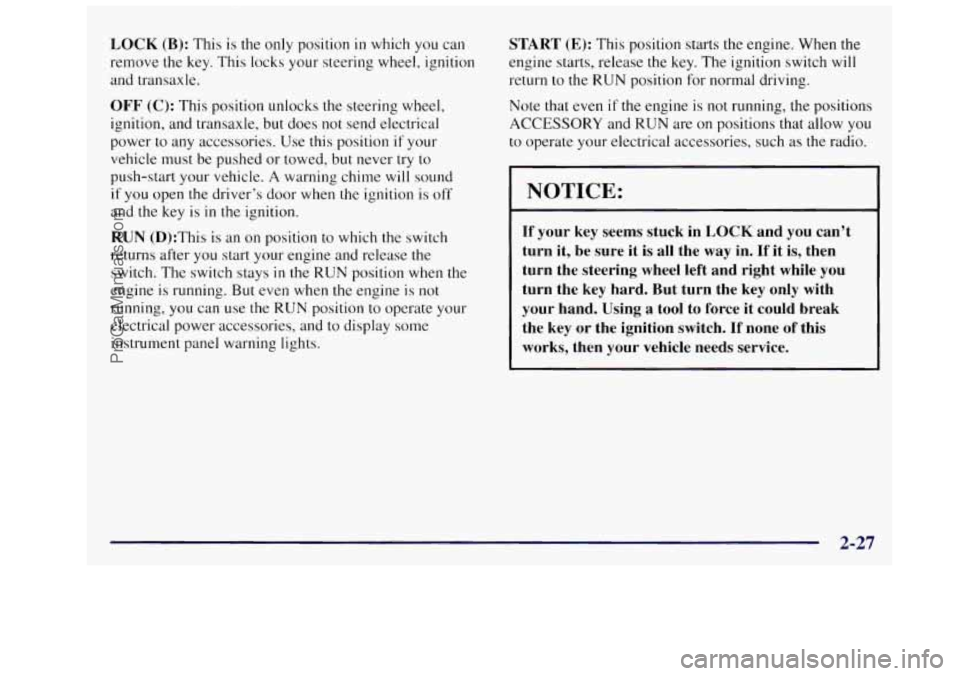
LOCK (B): This is the only position in which you can
remove
the key, This locks your steering wheel, ignition
and transaxle.
OFF (C): This position unlocks the steering wheel,
ignition, and transaxle, but does not send electrical
power to any accessories. Use this position if your
vehicle must be pushed or towed, but never try to
push-start your vehicle.
A warning chime will sound
if you open the driver’s door when the ignition is off
and the key is in the ignition.
RUN (D):This is an on position to which the switch
returns after
you start your engine and release the
switch. The switch stays
in the RUN position when the
engine is running. But even when
the engine is not
running, you can use the
RUN position to operate your
electrical power accessories, and to display some
instrument panel warning lights.
START (E): This position starts the engine. When the
engine starts, release the key. The ignition switch will
return to the
RUN position for normal driving.
Note that
even if the engine is not running, the positions
ACCESSORY and RUN are on positions that allow you
to operate your electrical accessories, such as the radio.
NOTICE:
If your key seems stuck in LOCK and you can’t
turn it, be sure it is all the
way in. If it is, then
turn the steering wheel left and right while
you
turn the key hard. But turn the key only with
your hand. Using
a tool to force it could break
the key
or the ignition switch. If none of this
works, then your vehicle needs service.
2-27
ProCarManuals.com
Page 116 of 436

Starting Your Engine
Move your shift lever to PARK (P) or NEUTRAL (N).
Your engine won’t start in any other position -- that’s a
safety feature.
To restart when you’re already moving,
use NEUTRAL
(N) only.
NOTICE:
Don’t try to shift to PARK (P) if your Oldsmobile
is moving.
If you do, you could damage the
transaxle. Shift to
PARK (P) only when your
vehicle is stopped.
1. Without pushing the accelerator pedal, turn your
ignition key to START. When the engine starts, let
go of the key. The idle speed will go down as your
engine gets warm.
NOTICE:
Holding your key in START for longer than
15 seconds at a time will cause your battery to
be drained much sooner. And the excessive heat
can damage your starter motor.
2. If it doesn’t start right away, hold your key in
START. If it doesn’t start in three seconds (or starts
but then stops), push
the accelerator pedal about
one-quarter
of the way down for 12 more seconds,
or
until it starts.
2-28
ProCarManuals.com
Page 117 of 436

3. If your engine still won’t start (or starts but then
stops), it could be flooded with too much gasoline.
Try this:
Wait
15 seconds to let the starter motor cool down.
Then push your accelerator pedal
all the way to the
floor. Hold
it there. Then hold the key in START.
This clears the extra gasoline from
the engine. When
the engine starts,
let go of the key and the accelerator
pedal.
If the engine still doesn’t start, wait another
15 seconds and repeat this step.
NOTICE: I
Your engine is designed to work with the
electronics in your vehicle.
If you add electrical
parts or accessories, you could change the way
the engine operates. Before adding electrical
equipment, check with your retailer.
If you don’t,
your engine might not perform properly.
If you ever have to have your vehicle towed, see
the part of this manual that tells how to do it
without damaging
your vehicle. See “Towing
Your Vehicle” in the Index.
Engine Coolant Heater (Option)
In very cold weather, 0” F (- 18°C) or colder, the engine
coolant heater can help.
You’ll get easier starting and
better
fuel economy during engine warm-up. Usually,
the coolant heater should be plugged in a minimum of
four hours prior to starting your vehicle.
2-29
ProCarManuals.com
Page 119 of 436
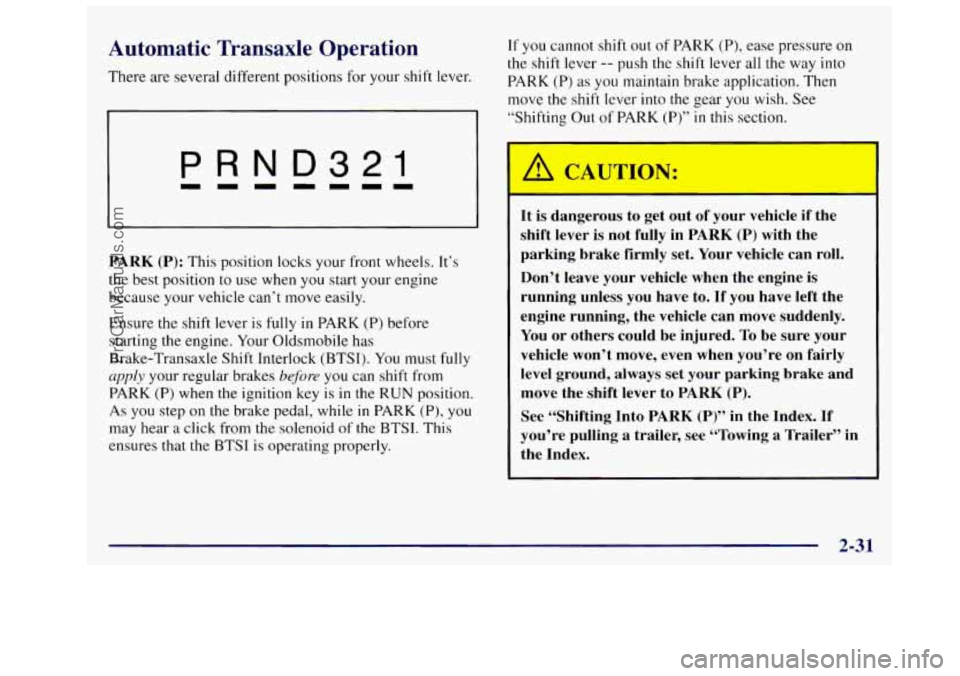
Automatic Transaxle Operation
There are several different positions for your shift lever.
PRND321
PARK (P): This position locks your front wheels. It’s
the best position to use when you start your engine
because your vehicle can’t move easily.
Ensure the shift lever is fully in PARK (P) before
starting the engine. Your Oldsmobile has
Brake-Transaxle Shift Interlock
(BTSI). You must fully
apply your regular brakes before you can shift from
PARK (P) when
the ignition key is in the RUN position.
As you step on the brake pedal, while in PARK (P), you
may hear a click from the solenoid of the BTSI. This
ensures that the BTSI
is operating properly.
If you cannot shi.ft out of PARK (P), ease pressure on
the shift lever
-- push the shift lever all the way into
PARK
(P) as you maintain brake application. Then
move the shift lever
into the gear you wish. See
“Shifting Out
of PARK (P)” in this section.
1 A CAUTION:
It is dangerous to get out of your vehicle if the
shift lever is not fully in
PARK (P) with the
parking brake firmly set. Your vehicle can roll.
Don’t leave your vehicle when the engine is
running unless you have to. If you have left the
engine running, the vehicle can move suddenly.
You or others could be injured.
To be sure your
vehicle won’t move, even when you’re on fairly
level ground, always set your parking
brake and
move the shift lever to
PARK (P).
See “Shifting Into PARK (P)” in the Index. If
you’re pulling a trailer, see “Towing a Trailer” in
the Index.
I
2-31
ProCarManuals.com
Page 125 of 436
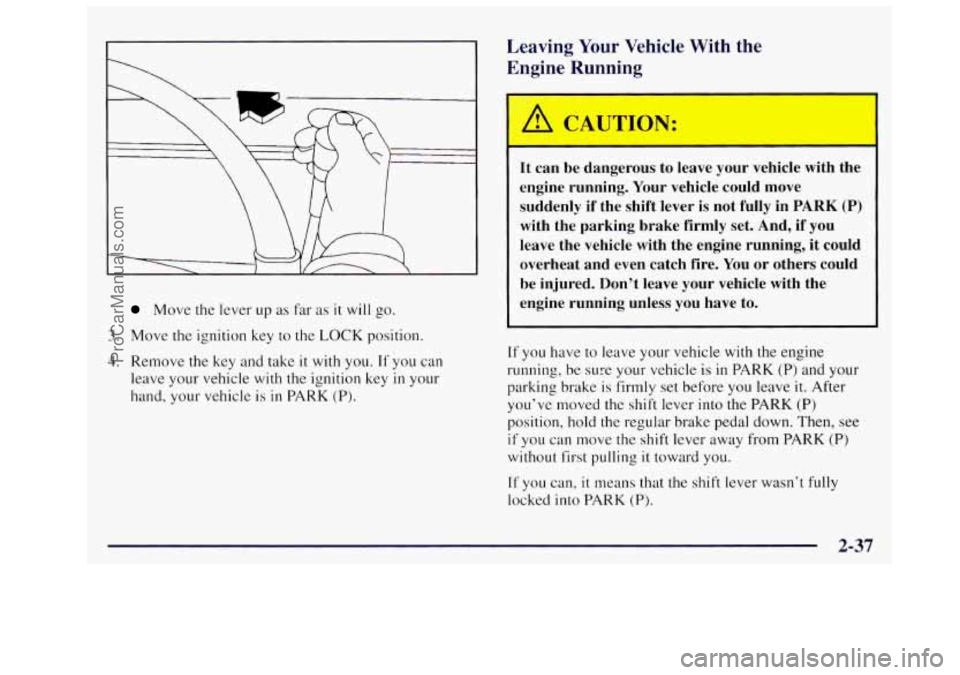
Move the lever up as far as it will go.
3. Move the ignition key to the LOCK position.
4. Remove the key and take it with you. If you can
leave your vehicle with the ignition key
in your
hand, your vehicle is in PARK
(P).
Leaving Your Vehicle With the
Engine Running
It can be dangerous to leave your vehicle with the
engine running. Your vehicle could move
suddenly if the shift lever
is not fully in PARK (P)
with the parking brake firmly set. And, if you
leave the vehicle with the engine running, it could
overheat and even catch fire. You or others could
be injured. Don’t leave your vehicle with the
engine running unless you have to.
If you have to leave your vehicle with the engine
running, be sure your vehicle is in PARK
(P) and your
parking brake is
firmly set before you leave it. After
you’ve moved the shift lever into the PARK
(P)
position, hold the regular brake pedal down. Then, see
if you can move the shift lever away from PARK (P)
without first pulling it toward you.
If you can, it means that the shift lever wasn’t fully
locked into PARK
(P).
ProCarManuals.com
Page 126 of 436
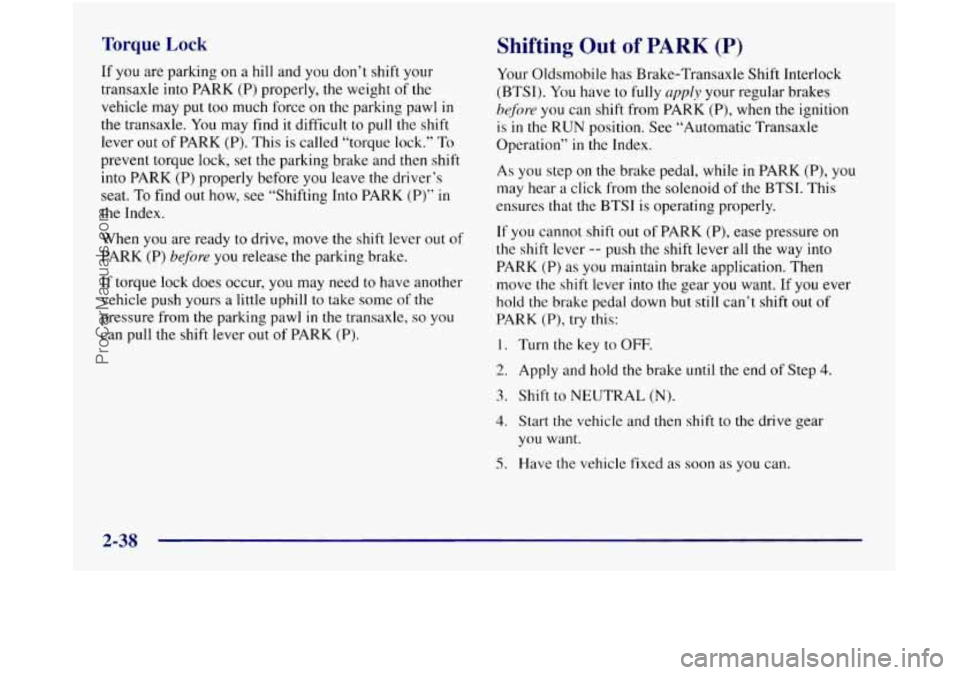
Torque Lock
If you are parking on a hill and you don’t shift your
transaxle into PARK
(P) properly, the weight of the
vehicle may put
too much force on the parking pawl in
the transaxle. You may find it difficult to pull the shift
lever out of PARK (P). This is called “torque lock.” To
prevent torque lock, set the parking brake and then shift
into PARK (P) properly before
you leave the driver’s
seat.
To find out how, see “Shifting Into PARK (P)” in
the Index.
When you are ready to drive, move the shift lever out of
PARK (P)
before you release the parking brake.
If torque lock does occur,
you may need to have another
vehicle push yours a little uphill
to take some of the
pressure from the parking pawl in the transaxle,
so you
can pull the shift lever out of PARK
(P).
Shifting Out of PARK (P)
Your Oldsmobile has Brake-Transaxle Shift Interlock
(BTSI). You have to fully
apply your regular brakes
before you can shift from PARK (P), when the ignition
is
in the RUN position. See “Automatic Transaxle
Operation”
in the Index.
As you step on the brake pedal, while in PARK (P), you
may hear a click from the solenoid of the BTSI. This
ensures that the
BTSI is operating properly.
If you cannot shift out of PARK (P), ease pressure on
the shift lever
-- push the shift lever all the way into
PARK (P)
as you maintain brake application. Then
move the shift lever into the gear you want. If
you ever
hold
the brake pedal down but still can’t shift out of
PARK
(P), try this:
1. Turn the key to OFF.
2. Apply and hold the brake until the end of Step 4.
3. Shift to NEUTRAL (N).
4. Start the vehicle and then shift to the drive gear
you want.
5. Have the vehicle fixed as soon as you can.
2-38
ProCarManuals.com
Page 130 of 436

To program features, your vehicle must be in the
programming mode. Follow these steps:
f FUSE USAGE CHART
10 TISIG 15 SIR io IGN 1 10 PSD
I N- I PWH WTJOmR 30 111 PWR QTR VENT RR HVAC FRT MED HVAC BLWR Low’ SUNROOF HVACIDRL
VENT
25 20 M FRT WPR WSHR SWC ACCY MALLIRADIOIDIC RH WPR WSHR BCM PRGRM
PWR SEAT/ HAZARD
15 STOP LAMP
20 10 2u PWR LOCK ABS MDL BAi7 RR PWR SCKT FRT HVAC HI 20 2 ABS SOL SWC BACK LIGHT
( For More information, See Owner’s Manual Printed in 10250877
1. The Content Theft Deterrent system (if equipped)
must be disarmed.
2. Remove the BCM PRGRM fuse from the instrument
panel fuse block.
3. Turn the ignition switch to ACCESSORY.
4. You will hear two to four chimes, depending upon
the features that you have.
You can now program your choices.
Leaving Programming Mode
To get out of programming mode, just turn the key from
the ACCESSORY position to OFF and put the BCM
PRGRM fuse back into the instrument panel fuse block.
Delayed Illumination and Exit Lighting
Your vehicle comes with this feature set in Mode 4. This
means that:
0 The interior lamps will stay on for a while after all
the doors and the liftgate are closed.
0 The interior lamps will come on and stay on for a
while whenever you remove the key from the ignition.
2-42
ProCarManuals.com
Page 131 of 436
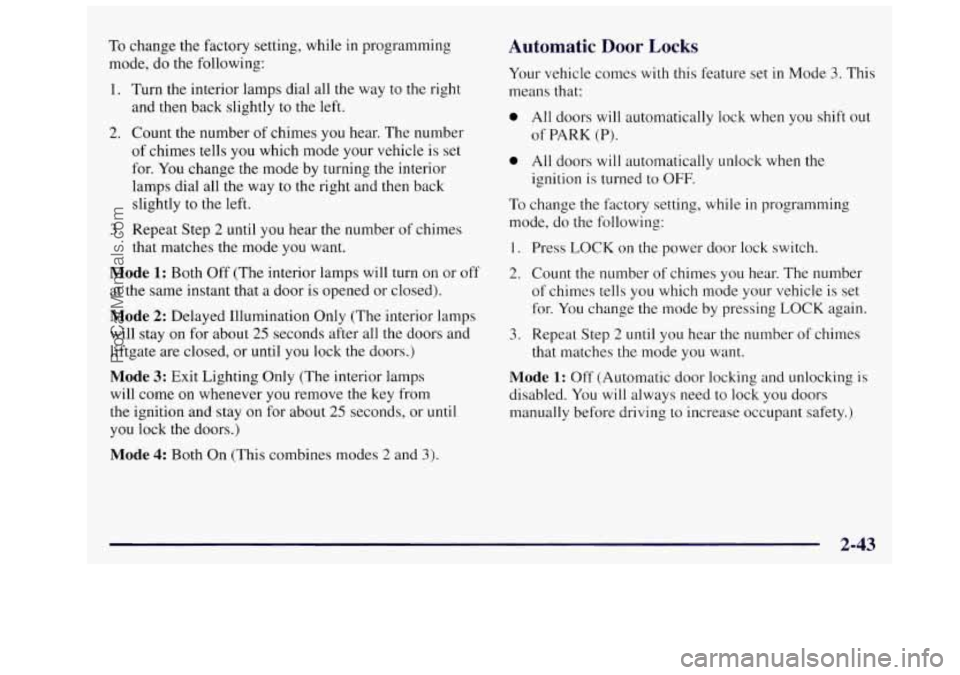
To change the factory setting, while in programming
mode, do the following:
1.
2.
3.
Turn the interior lamps dial all the way to the right
and then back slightly to the left.
Count the number of chimes you hear. The number
of chimes tells you which mode your vehicle is
set
for. You change the mode by turning the interior
lamps dial all the way to the right and then back
slightly to the left.
Repeat Step
2 until you hear the number of chimes
that matches the mode you want.
Mode 1: Both Off (The interior lamps will turn on or off
at the same instant that
a door is opened or closed).
Mode 2: Delayed Illumination Only (The interior lamps
will stay on for about
25 seconds after all the doors and
liftgate are closed, or until you lock the doors.)
Mode 3: Exit Lighting Only (The interior lamps
will come
on whenever you remove the key from
the ignition and stay on for about
25 seconds, or until
you lock the doors.)
Mode 4: Both On (This combines modes 2 and 3).
Automatic Door Locks
Your vehicle comes with this feature set in Mode 3. This
means that:
0 All doors will automatically lock when you shift out
of PARK (P).
0 All doors will automatically unlock when the
ignition
is turned to OFF.
To change the factory setting, while in programming
mode, do the following:
1. Press LOCK on the power door lock switch.
2. Count the number of chimes you hear. The number
of chimes
tells you which mode your vehicle is set
for.
You change the mode by pressing LOCK again.
3. Repeat Step 2 until you hear the number of chimes
that matches the mode you want.
Mode 1: Off (Automatic door locking and unlocking is
disabled. You will always need to lock you doors
manually before driving to increase occupant safety.)
2-43
ProCarManuals.com